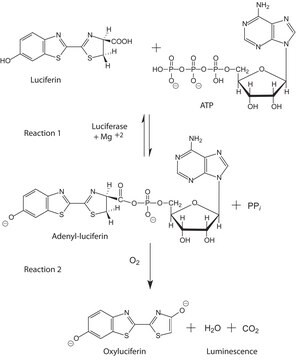MAK133
ADP Assay Kit
sufficient for 100 assays (bioluminescent)
Se connecterpour consulter vos tarifs contractuels et ceux de votre entreprise/organisme
About This Item
Code UNSPSC :
12161503
Nomenclature NACRES :
NA.84
Produits recommandés
Utilisation
sufficient for 100 assays (bioluminescent)
Méthode de détection
chemiluminescent
Maladie(s) pertinente(s)
hematological disorder; cancer
Température de stockage
−20°C
Description générale
Adenosine diphosphate (ADP) is a nucleoside that plays a critical role in energy transfer reactions. ADP is produced from adenosine triphosphate via the action of ATPases. ADP also plays a critical role in platelet function. ADP, stored in plate-dense granules, is released upon platelet activation where it acts on purinergic receptors to mediate intracellular signaling and platelet aggregation.
The ADP Assay kit provides a simple and direct procedure for measuring ADP levels in cells and other biological samples. The assay involves two steps. In the first step, the working reagent lyses cells to release ATP and ADP. In the presences of luciferse, ATP immediately reacts with the Substrate (D-luciferin) to produce light. The light intensity is a direct measure of the intracellular ATP concentration and is stable over several minutes.
In the second step, the ADP is converted to ATP through an enzyme reaction. This newly formed ATP then reacts with the D-luciferin as in the first step. The second light intensity measured represents the total ADP and ATP concentration in the sample.
The ADP Assay kit provides a simple and direct procedure for measuring ADP levels in cells and other biological samples. The assay involves two steps. In the first step, the working reagent lyses cells to release ATP and ADP. In the presences of luciferse, ATP immediately reacts with the Substrate (D-luciferin) to produce light. The light intensity is a direct measure of the intracellular ATP concentration and is stable over several minutes.
In the second step, the ADP is converted to ATP through an enzyme reaction. This newly formed ATP then reacts with the D-luciferin as in the first step. The second light intensity measured represents the total ADP and ATP concentration in the sample.
Adéquation
Suitable for the detection of ADP in cells, tissue and other biological samples.
Principe
The ADP Assay kit provides a simple and direct procedure for measuring ADP levels in cells and other biological samples. The assay involves two steps. In the first step, the working reagent lyses cells to release ATP and ADP. In the presences of luciferse, ATP immediately reacts with the substrate (D-luciferin) to produce light. The light intensity is a direct measure of the intracellular ATP concentration and is stable over several minutes.
Luciferase ATP + D-Luciferin + O2 → oxyluciferin + AMP + PPi + CO2 + light
In the second step, the ADP is converted to ATP through an enzyme reaction. This newly formed ATP then reacts with the D-luciferin as in the first step. The second light intensity measured represents the total ADP and ATP concentration in the sample.
Luciferase ATP + D-Luciferin + O2 → oxyluciferin + AMP + PPi + CO2 + light
In the second step, the ADP is converted to ATP through an enzyme reaction. This newly formed ATP then reacts with the D-luciferin as in the first step. The second light intensity measured represents the total ADP and ATP concentration in the sample.
Mention d'avertissement
Warning
Mentions de danger
Conseils de prudence
Classification des risques
Aquatic Chronic 3 - Skin Sens. 1
Code de la classe de stockage
10 - Combustible liquids
Certificats d'analyse (COA)
Recherchez un Certificats d'analyse (COA) en saisissant le numéro de lot du produit. Les numéros de lot figurent sur l'étiquette du produit après les mots "Lot" ou "Batch".
Déjà en possession de ce produit ?
Retrouvez la documentation relative aux produits que vous avez récemment achetés dans la Bibliothèque de documents.
The membrane ATPase of Escherichia coli: I. Ion dependence and ATP-ADP exchange reaction.
Roisin M P and Kepes A
Biochimica et Biophysica Acta - Bioenergetics, 275(3), 333-346 (1972)
Hongshan Ge et al.
Molecular and cellular endocrinology, 443, 128-137 (2017-01-17)
To explore the roles of mitochondrial Uncoupling Protein 2 (UCP2) in cumulus cells (CCs), human CCs were cultured in vitro, and the UCP2 was inhibited by treatment with Genipin, a special UCP inhibitor, or by RNA interference targeting UCP2. No significant
Sepinoud Firouzmand et al.
Neurourology and urodynamics, 39(3), 926-934 (2020-02-13)
To characterize purinergic signaling in overactive bladder (OAB). Mucosal biopsies were taken by flexible cystoscopy from patients with storage symptoms referred to Urology Departments of collaborating hospitals. Immunohistochemistry (n = 12) and Western blot analysis (n = 28) were used to establish the qualitative
Aggregation of blood platelets by adenosine diphosphate and its reversal.
Born G V R
Nature, 194(4832), 927-929 (1962)
Yingzhong Li et al.
Nature communications, 11(1), 4837-4837 (2020-09-26)
ATP synthesis and thermogenesis are two critical outputs of mitochondrial respiration. How these outputs are regulated to balance the cellular requirement for energy and heat is largely unknown. Here we show that major facilitator superfamily domain containing 7C (MFSD7C) uncouples
Notre équipe de scientifiques dispose d'une expérience dans tous les secteurs de la recherche, notamment en sciences de la vie, science des matériaux, synthèse chimique, chromatographie, analyse et dans de nombreux autres domaines..
Contacter notre Service technique





